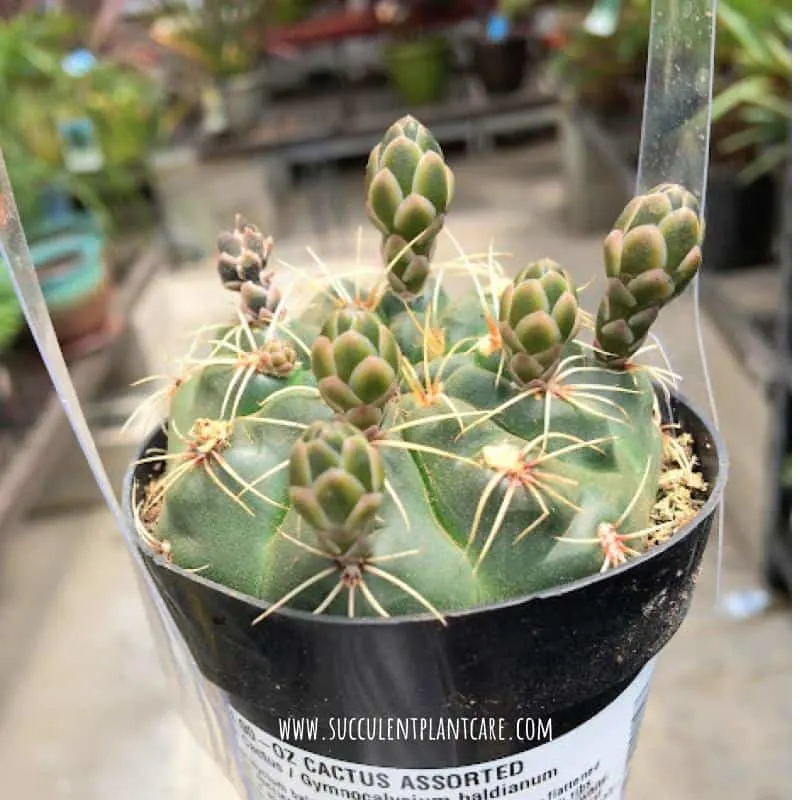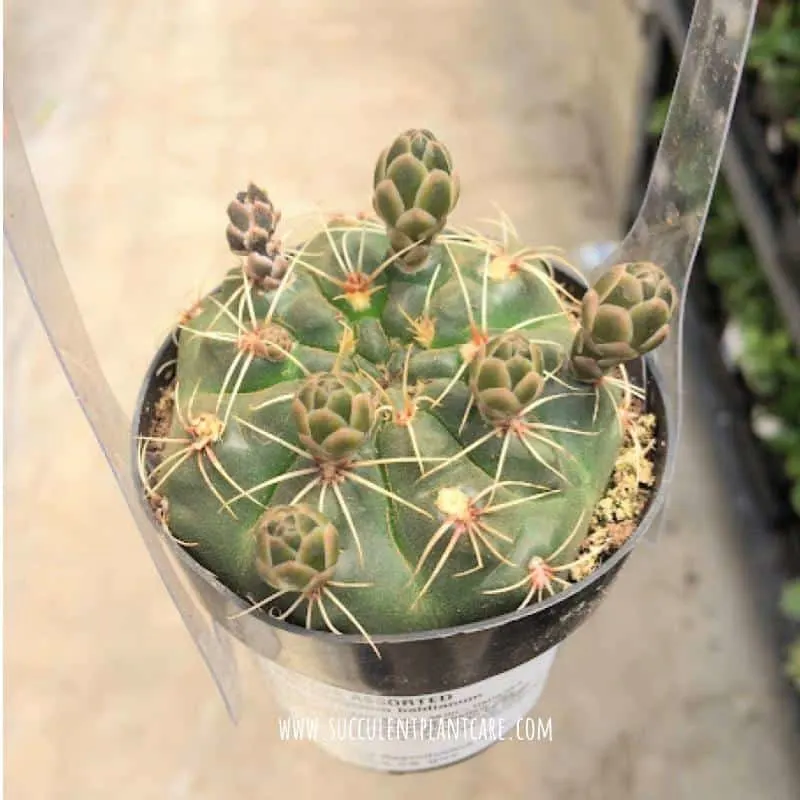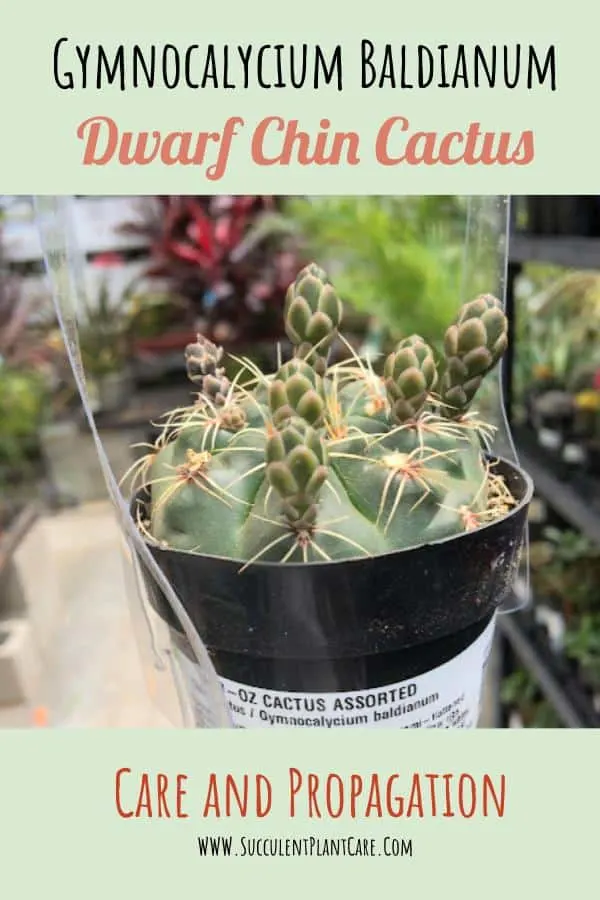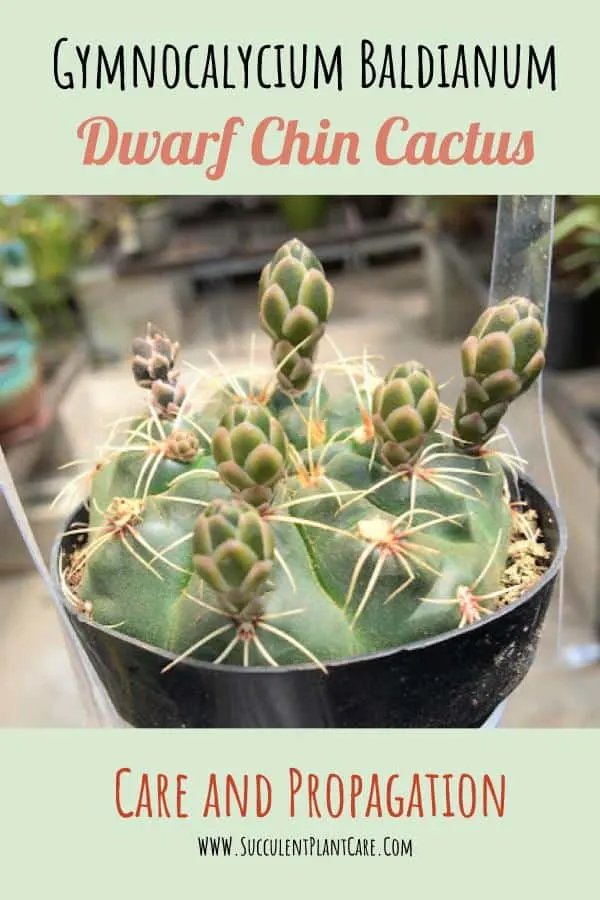Gymnocalycium baldianum ‘Dwarf Chin Cactus’ is native to the mountainous and grassy regions of Argentina. Also known as Echinocactus badianus and Gymnocalycium platense var. baldianum, it is a bulb-shaped, semi-flatted cactus, 3 to 5 inches (8 to 13cm) in diameter. It usually grows up to 3 to 4 inches (7.62 to 10.16 cm) tall and consists of unbranched, flattened, spherical stem.
It consists of 9 or 11 wide ribs with 5 to 7 radial spines that are light gray in color. It produces magenta, orange, purple-red, or white flowers that are about 1.5 inches or 4 to 6 cm in diameter. This plant flowers freely in the spring and summer months.

Is the Gymnocalycium Baldianum an Indoor or outdoor plant?
The Gymnocalycium baldianum can be grown both indoors and outdoors. One thing you should know about this plant is it prefers partial shade as opposed to direct sunlight. It can do well indoors as well as outdoors, so long as you provide it with the proper care that it needs to thrive. If grown indoors, it needs proper ventilation and air circulation for it to thrive. It does not do well in stagnant air.
Indoor lighting requirements
Indoor Lighting Preference: Bright Indirect Light, well-ventilated room
Gymnocalycium Baldianum is a shade-seeking plant. When grown indoors, place in the brightest area in the house. However, you need to protect the plant from extreme sun exposure that can happen when placed in a south-facing window or when placed next to a window that receives direct afternoon sun.
Take care not to place the plant right next to a window that gets really hot or that receives direct or intense sunlight. The ideal location for this plant indoors is in the brightest area in the house but with light shade or protection from the direct afternoon sun. When kept indoors during really hot summer days, provide the plant with fresh air and ventilation, as well as relief from the heat.
Provide at least 4-6 hours of bright, indirect light. During winter time when the days are shorter, or when indoor lighting is inadequate, you may consider using a grow light to supplement your plant’s lighting needs. Here are some of my grow light recommendations. Too much shade and not enough light will also be detrimental for this plant.
Outdoor sunlight requirements
Outdoor Sunlight Preference: Light Shade to Partial Shade
In the summer or during extreme heat, Gymnocalycium baldianum needs to be protected from the intense sun’s rays. Extreme sunlight can damage the plant and will result in the plant failing to flower. To keep it happy outdoors during the summer heat, light shade or filtered light is required. This plant will not do well in full sun.
In its native habitat it grows in grasslands and shady areas, protected from direct sunlight. For this reason, it usually prefers partially shaded, well-ventilated, cool areas. Under extreme heat or full sun, the roots can get damaged from shock and heat. The plant will then be unable to absorb the water that it needs for survival.
When a heatwave is expected or when the weather is expected to get really hot, move the plant to a shadier location. Placing the plant next to a taller plant may do the trick, or placing it under a lawn chair or under a table to provide shade. If needed, use sunshades to protect them from heat.
Sunshades can be a lifesaver for these plants especially in areas where the sun’s heat can really scorch the plant. Here are some of my sun protection recommendations. Gymnocalycium baldianum’s growing season is during mid to late spring and early summer.

Frost Tolerance
Hardiness Zone: USDA zones 8b to 10b (15 to 40 °F or -6.7 to 4.4 °C)
These plants will tolerate mild frost but not for long periods of time. If you live in USDA zones 8b to 10b, or if you have mild winters in your area, you may get away with growing your Gymnocalycium baldianum outdoors all year long. They can even be planted in the ground.
However, if you live in an area with extreme winter conditions, the best way to grow these plants is in containers. That way you can move them indoors or move them to a greenhouse during the winter to be protected from freezing temperatures. If you must keep them outdoors during wintertime, provide protection from frost by using a blanket or frost cloths. Here are some of my frost protection recommendation.
The plant must be kept dry in the winter when the temperature reaches around 14°F (-10°C) or less. The ideal temperature for the Gymnocalycium baldianum to thrive is between 59-86 °F (15 to 30 °C).
Soil requirements
To provide the best growing environment for these plants, well-draining, porous soil is required. What I usually do is I use a standard cactus mix and combine it with perlite for extra drainage. I eyeball it to about 1:1 solution of cactus mix and perlite. You can also use a sandy mixture or coarse sand and cactus mix (1:1 solution). Or you can use a combination of these three materials (1:1:1 solution of cactus mix, perlite and coarse sand) for a porous soil mixture.
You can find most of these materials from a local garden center. To find them online, click on my resource page for my soil and soil amendment recommendations. To read more about this topic, click on my post “Best Soil and Fertilizer for Succulents and Cacti” for further details.
The Gymnocalycium baldianum does not need to be repotted very often and can remain in the same pot for years. You can replenish the nutrients lost in the soil by fertilizing during the growing season. Use ¼ to ½ strength of the recommended dosage on the label, about every two weeks to once a month is good enough. Here are my fertilizer recommendations.
When repotting, try to do so with dry soil to make it easier to remove the plant from the pot. Leave the soil dry for a few days before watering to allow the plant to heal and recover from the shock of repotting. After a few days to about a week, water the plant thoroughly and do not water again until the soil is dry.
Watering requirements
The watering needs of your Gymnocalycium Baldianum varies according to the season and the size of the plant. An established plant needs less watering than a younger plant.
Here are some of the things you need to know about watering this plant:
- In-ground plant – if your cactus is growing in the ground, a deep soak watering method is best. This is where you water the base of the plant thoroughly until it’s had a good soaking. Then you leave it alone until the soil feels dry. When using this method, you do not need to water your plant very often. Once every 10-14 days in the summertime should be sufficient. You may need to water more when the weather gets very hot or during an intense heatwave. Decrease watering when the weather cools down during the spring and fall seasons.
- Potted plant – if your cactus is growing in a container inside, watering once every 7-10 days for smaller plants and every 7-14 days for bigger plants in the summertime is a good way to start. You may need to water more during a heatwave. Water the plant thoroughly and drain out any excess water that may have drained out of the pot. Do not water again until the top inch of the soil feels dry.
- Transplanted or new plant – if you are repotting the cactus or adding pieces to your landscapes and pots, do not water the newly planted specimen right away. Allow the plant to settle for at least a few days to a week in the dry soil so that the roots can recover and adapt. After that, you can water it as described above.
- Wintertime – When temperatures drop during the winter months, watering requirements change. There is usually very little need to water the cactus unless there is less than 1 inch (2.54 cm) of rainfall over a period of 30 days. If rainfall is less than 1 inch (2.54 cm), water the plant about once a month, so the soil does not completely dry out is sufficient.
Plants that are kept indoors over the winter do not need to be watered as much. Watering once a month or once every four weeks, or less, to prevent the soil from drying out completely should be sufficient.

Propagation
Gymnocalycium baldianum can be propagated by harvesting its seeds or by the offsets it produces. The seeds can be cultivated in the early spring when the temperature is about 66 to 75 °F or 19 to 24 °C. Harvesting and sowing the seeds for propagation require time and patience. Offsets are perhaps the best option of propagation for this particular cactus. Of course you would need to wait for offsets to grow and develop before this can take place. Offsets form around the base of a mature plant.
Follow these steps to successfully propagate from offsets:
- Take care to gently remove the offsets from the mature plant. Wear protective gloves and use foam, cardboard, or other barriers to protect your fingers from the sharp spines.
- Place the offsets onto a piece of paper towel or in a dry location and allow them to dry out. This may take a few days depending on the humidity in your area.
- You will notice a scab-like growth forming over the cut area, which is called a callus. Optional: Once dry, you can dip the cut end in rooting hormone. Rooting hormone is optional and not a must but can help speed up the rooting and propagation process).
- Prepare a pot or small container with well-draining cactus growing soil.
- Once the offsets have dried, plant the callus edge into the soil.
- Water every few days or when the soil feels dry. Place the container in a bright spot but away from direct sunlight. Allow the plant to establish itself over a few weeks before exposing it to more sunlight.
Blooms
Gymnocalycium Baldianum produces exquisite, bright flowers. It flowers readily and can stay in bloom for weeks. If your Gymnocalycium Baldianum is not blooming as expected, there are ways to encourage blooms. Keep in mind that not all cacti are ready to bloom, and some may not bloom at all.
Encouraging better flowering requires a cooling period in winter. You should also hold back on watering during the winter months. Providing the Gymnocalycium Baldianum with too much water will deter flower growth. If the plant remains damp or sits in water for too long, the plant will fail to flower completely.
After reducing water to an absolute minimum during winter and allowing the plant to be somewhat dormant, you can boost flowering in the spring and summer months. You can do this by increasing your watering steadily and feeding the plant with a liquid fertilizer. Fertilizers are better applied at a quarter or half strength, about every two weeks during the growing season. A balanced blend of fertilizer or a fertilizer formulated for cacti and succulents diluted to half strength are both suitable. Here are some of my fertilizer recommendations.
Gymnocalycium Baldianum does not do very well under extreme heat or full sun. When kept under these conditions, the plant will fail to flower. However, if the plant is kept in the shade for too long without sufficient light, it will also fail to flower. Partial to light shade is best for this plant.
Is the Gymnocalycium Baldianum toxic or poisonous?
Gymnocalycium Baldianum is not known to be toxic to pets. However, due to the presence of sharp spines, care is needed when handling this plant to prevent injuries. If you suspect poisoning, contact your local veterinarian or poison control immediately.
Gymnocalycium Baldianum is an easy cactus that can be grown indoors and out. It is generally disease-free and produces attractive, bright flowers quite readily.
Wondering where you can find these and other cacti online? Visit my resource page for recommendations on where to purchase succulents and cacti.
Pin this to save for later or share with others now!


